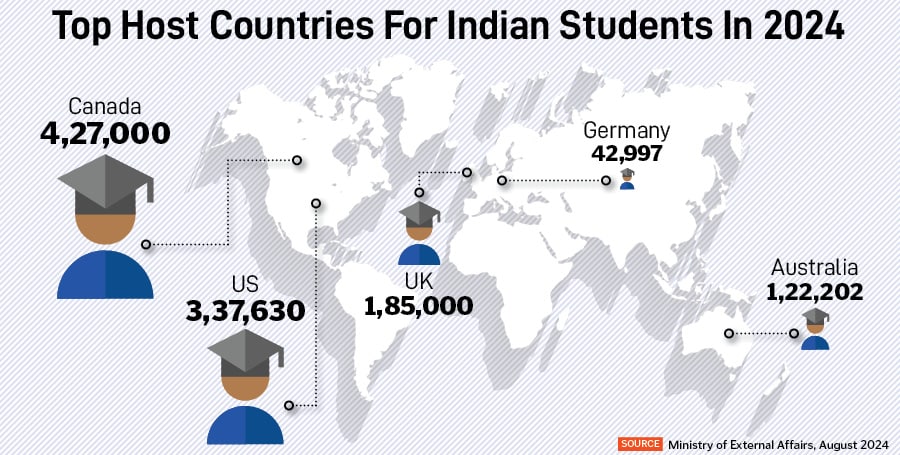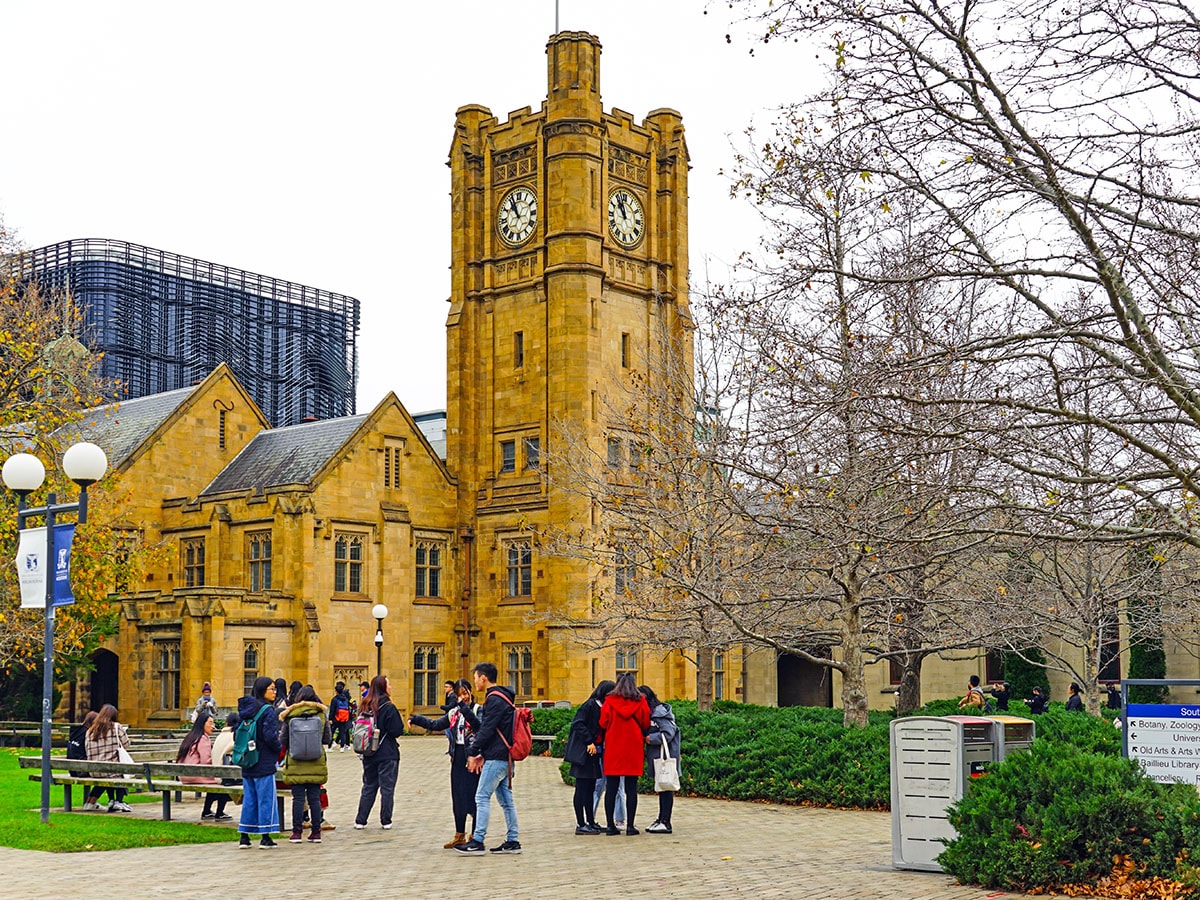 Students should stay updated on their destination country’s evolving labour market trends. Image: Shutterstock
Students should stay updated on their destination country’s evolving labour market trends. Image: Shutterstock
In 2024, Indian students seeking international education found themselves navigating a turbulent terrain with popular study-abroad destinations introducing new regulations. Australia and the United Kingdom hiked visa fees substantially, and the country with the highest Indian student population, Canada, implemented caps on admissions and it will further reduce by 10 percent in 2025. Moreover, applying for an F1 visa to study in the United States became tougher.
While the heightened challenges led to students reconsidering their fields of study to choose those that offer more stable employment options, or look to destinations such as Ireland and Germany, education counsellors say planning strategically for 2025 could still help them stick to plan A.
“Consider policy changes as temporary,” says Namita Mehta, president and partner at the Mumbai-based education consultancy, The Red Pen. “Students should monitor changes in the political environment of the countries they’re targeting, as these rules may evolve by the time they complete their studies. Being adaptable and prepared for policy shifts can help them navigate changes effectively,” she adds.
To address the housing crisis and prevent fraud in the visa system, Canada implemented a two-year cap on study permits, cutting approvals by 35 percent in January 2024. The country is home to 4.27 lakh Indian students—the largest nationality—as of 2024, according to the Ministry of External Affairs. And it is set to restrict the number of study permits to 4.37 lakh in 2025, an additional 10 percent reduction from 2024.
Additionally, with effect from November 2024, university graduates must meet a Canadian Language Benchmark (CLB) level 7 and college graduates should obtain a CLB level 5 to qualify for the Post-Graduation Work Permit—a crucial pathway for international students to remain and work in the country after their studies.
Mehta explains that this may be difficult for students who struggle with English proficiency. And students pursuing non-STEM (Science, Technology, Engineering, Mathematics) fields—where language proficiency is important—may find it challenging to meet these requirements, further limiting their post-graduation employment prospects.
To combat visa fraud with rising concerns about individuals overstating their financial means to gain entry into the country, students must now show a minimum of CAD 20,635 (Rs 12.19 lakh) as compared to CAD 10,000 (Rs 5.9 lakh) for living expenses and education along with providing a more detailed proof of their ability to finance these.
“These stricter financial requirements may prove particularly challenging for middle-class families in India. Meeting these requirements could discourage some students from applying to Canadian institutions altogether,” says Mehta.
Australia:
To manage the growing number of international students, address housing shortages, and ensure alignment with Australia’s labour market needs, Australia too introduced regulations in 2024, affecting Indian students—the second-largest international student demographic (15 percent) in the country.
In July 2024, the student visa application fee was raised from AUD 710 (Rs 37,602) to AUD 1600 (Rs 84,737). And they now require proof of at least AUD 29,710 (Rs 15.73 lakh) from AUD 24,505 (Rs 12.97 lakh) in funds to cover living expenses.
The US and the UK:
For studies in the US, not only has it become tougher to find visa slots, but the F-1 visa—a non-immigrant visa that allows international students to study in the United States at an accredited institution—process has become more stringent.
According to a news report citing the US State Department data, India witnessed a major decline in US F-1 student visas with just 64,008 issued from January to September in 2024—a 38 percent fall from 1.3 lakh in 2023.
For studying in the United Kingdom, the visa fee has surged to £490 (Rs 52,134) with an increase of 35 percent. Plus, international students are expected to demonstrate strong financial resources to support themselves during the stay, starting January 2, 2025.

Emerging alternatives
As a direct result of the new policies, education counselors say students have approached them to reconsider their fields of study and destinations.
“There was a noticeable shift in student preferences with Ireland becoming a top choice due to its 90 percent visa success rate,” says Palak Neema, founder of Mumbai-based education consultancy Learner Aid.
European countries such as Germany, Finland, Spain, France, are also seeing increased interest, she informs, with many of these countries also introducing English-language programs for international students.
“This has opened up access to high-quality education in Europe for non-native speakers, particularly Indian students,” Neema adds.
Moreover, Asian and Middle Eastern countries like the United Arab Emirates and Singapore have also gained popularity, says education consultant Karan Gupta. He adds Netherlands and New Zealand are also emerging as alternatives for Indian students looking for high-quality education without as many hurdles.
Also read: Democratising Education in India: Breaking barriers and building bridges
Sticking to the original plan
The new policies, coupled with stricter rules on employment, and high tuition and living costs may have prompted students to seek more affordable alternatives, but it may not be the right approach as it may lead to dissatisfaction in the long run, says Mehta.
Therefore, despite the challenges, students can still stick to their original plans, keeping the following points in mind:
Academic and language preparation
The Red Pen: With the competition increasing for limited spots due to caps, students must ensure their academic records are exceptional. High grades in relevant subjects and strong test scores in SAT, ACT, GRE, and GMAT will help students stand out in a competitive pool. Additionally, with these countries increasing their standards for English language proficiency, Indian students must prepare for exams like IELTS, TOEFL, or PTE, even if they are well-versed in the language. The idea is to exceed expectations and requirements.
Learner Aid: It will help to schedule and begin preparations for these tests early, since it’ll be one less component to worry about if they’ve achieved a good score. It will also allow time for retakes if needed and give more flexibility in securing scholarships and financial aid. Early submission of applications will help avoid last-minute complications.
Australia, in particular, has introduced a requirement for students to prove a genuine intent to study. Students must be clear about their academic goals and career aspirations in their statements and during visa interviews. This may require counselling or coaching to ensure they effectively communicate their commitment to education and not just immigration opportunities, hence it’s beneficial to lock down an expert early on in the process.
Enhance your profile
The Red Pen: Since universities and visa officers often evaluate holistic profiles, students must demonstrate leadership, community involvement, or unique talents. Volunteering or entrepreneurial ventures in fields relevant to the course of study can strengthen applications and make them more competitive.
Learner Aid: If your academic background is not strong, consider pursuing certifications, internships, or relevant work experience to enhance your application. These additional qualifications will impact your chances.

Financial preparedness
The Red Pen: Indian students should gather all necessary financial documents early, including bank statements, proof of family income, sponsorship letters, scholarships, and education loan documents. It is important to show that funds cover tuition fees, accommodation, and living expenses for the duration of the program.
The intent to apply for visas should be purely educational. It also helps to demonstrate intent to return to India by providing documentation to show that you are rooted in your home country. This could be giving property papers or proof of a family business.
Learner Aid: These documents are often scrutinised closely during visa processes, especially in countries like Australia.
Families need to approach financial planning with foresight. Start budgeting early for tuition and living expenses, considering additional costs like visa fees, insurance, flight tickets and potential unforeseen expenses.

Education loans are a smart option, especially those with deferred repayment plans that allow students to repay once they begin earning post-graduation. These loans often come with interest-only payment options during the study period, which can decrease the financial load for families. Opting for fields that provide high returns on investment can further ensure that students are positioned to secure well-paying jobs after graduation, making loan repayment easier.
Researching scholarships or grants in these countries can also help reduce costs, ensuring that education quality is not compromised.
Consider policy changes as temporary:
The Red Pen: Political and economic landscapes often influence policies that cap international student admissions or work opportunities. Students should stay updated on their destination country’s evolving labour market trends. This can help them tailor their academic focus or career aspirations to meet the demand for specific skills and ensure a smoother transition into the workforce.
All currency conversion rates in INR as of December 20, 2024.
